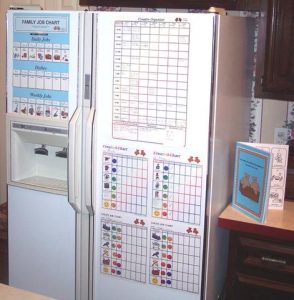Who’s responsible for household storage and organization?
This is a question that needs to be answered by every household. When it’s not, the satisfaction that comes from getting common spaces organized and all lesser used items carefully stored away will be quickly undermined by either re-emerging clutter or feelings of resentment.
It’s not pleasant to be the only tidy person in a family of mess makers.
 If this sounds like a problem that you may have to confront, don’t let this deter you from creating order out of chaos in your home. There are strategies to split responsibility for chores and tasks within a family or group, and they can be implemented fairly painlessly to make household responsibility allocation less stressful. The most important task is to make everyone fully familiar with the new system. Household members, especially children, who do not understand your new storage schema will not be able to do their part, no matter how loudly or often you nag them.
If this sounds like a problem that you may have to confront, don’t let this deter you from creating order out of chaos in your home. There are strategies to split responsibility for chores and tasks within a family or group, and they can be implemented fairly painlessly to make household responsibility allocation less stressful. The most important task is to make everyone fully familiar with the new system. Household members, especially children, who do not understand your new storage schema will not be able to do their part, no matter how loudly or often you nag them.
Make it clear from the beginning. Here are three basic steps to get you started:
- Draw a diagram of responsibilities and tasks.
- Post everything publicly.
- Hold a family meeting.
Everyone should be clear on where things belong and why putting them away is important for household function and harmony. During your family meeting hash out individual responsibilities. This can be a bit complicated because ownership of certain spaces may be unclear. It’s fairly simple to explain to a child that the responsibility for keeping his room clean and orderly falls on him. It’s his room.
But what about a family room or a garage? Kids are especially adept at trying to shed blame, so be clear and firm with your expectations, and make sure that one person in the house is not set up as “the bad guy.” Order helps everyone, and so it should be everyone’s responsibility. This may mean setting up a hierarchy of older children being responsible for younger children doing their part. It may also mean that no one can watch television or play on smartphones until everything has been picked up according to predetermined standards. Build in incentives and disincentives to your program, n the beginning, be careful to follow through with them, and you will find that it takes on its own inertia over time.
Many children will respond well to tracking their achievements. Post lists of their chores and responsibilities in a common area along with a sticker board to document how they are accomplishing them. For larger achievements (for example, a month of great work), be generous with both praise and rewards. If keeping the family room clean is a goal you are working on, reward good work with a group reward that reinforces family identity and good feelings – like a family game or movie night. Kids pick the movie and the food. And they help pick up afterward, of course. If the family outing for today involves bicycling, but when everyone goes to saddle up the garage is a mess, the fun doesn’t start until that is rectified. Also, gently but firmly hold whoever was responsible for the failure responsible then and there. It’s easy for parents (or spouses) to forget this, but enabling irresponsibility is not helpful and it doesn’t create stronger families.
It’s always a good idea to reinforce group participation. No one should walk away from the table after dinner – except for whoever cooked if that is part of your family’s core distribution. There’s plenty of work for everyone to do, and even a toddler can carry her own plate to the sink. When the dishes have been wiped off and put in the dishwasher when the table is clean again when all of the chairs are tidy and any leftovers have been put away – that’s when dinner is over and everyone can leave. Reinforcing group responsibility in accomplishing smaller tasks will help everyone to get in the habit and extend that habit to larger chores as well.
Inevitably, there’ll be conflict when tasks don’t get done and a mess results. But don’t let this deter you from your goal.
To err is human, after all. This is why it’s so important to set up objective goals and standards. When the living room is messy, it should be easy to look at the chore chart and determine whose responsibility that is. People are remarkably good at putting pressure on others — particularly family members — to save themselves extra work especially if they know they will not be bailed out.
If a real squabble breaks out, use it as an opportunity to re-emphasize both responsibility and group goals. Don’t forget to bring up accomplishments or successes, too. The point of this all this work is to make life easier and simpler. If you can point out how a failure can be turned into a success and how that success helps everyone, you have a lesson learned instead of a fight. And learning how to work cooperatively with others to achieve goals is a vital skill for everyone to have.


